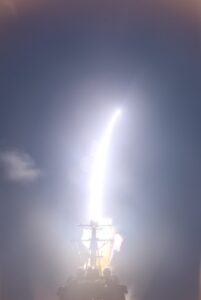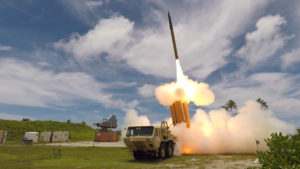The latest annual report by the Pentagon’s top weapons tester said while the Missile Defense Agency’s (MDA) systems have largely demonstrated several capabilities the biggest challenge is the need for realistic and emerging threat representations in testing the interceptors.
The fiscal year 2022 report of the Director of Operational Test and Evaluation (DOT&E) was released on Jan. 20. It noted MDA performed 24 flight, ground, cybersecurity and high-fidelity modeling and simulation (M&S) tests during FY ‘22. This covered a range of capabilities including regional/theater defense with Patriot and Terminal High Altitude Area Defense (THAAD) systems; hypersonic weapon defense concepts; and homeland defense, focusing on the Ground-based Midcourse Defense system.

DOT&E said while MDA continued testing “the need for additional threat representations, independently accredited M&S, and system survivability data in a cyber-contested environment present significant challenges for DOT&E in completing a comprehensive assessment of the MDS.”
The report specifically argued realistic and up-to-date representations of threats scenes are “critical to the assessment of MDS performance” because “the rate of adversary threat development is currently faster than the pace of flight test target and ground test as well as high-fidelity M&S threat model development.”
The report also said flight and ground test programs have been limited in the variety of realistic threat countermeasures, electronic attack, post-intercept debris scenes, raid sizes, and multi-element engagement scenarios tested.
“The MDA often designs flight tests to demonstrate a specific new capability, but relevant intercept flight tests could provide needed referent data to support verification, validation, and accreditation models used in high-fidelity M&S ground testing, provide realistic data on multi-element interactions, and provide data in multi-domain operations.”
“Furthermore, M&S limitations in ground tests are sometimes minor when assessing an element alone but combine to create substantial impediments at the MDS-level,” the report continued.
DOT&E said the main missile defense system programs demonstrate at least basic capabilities they aim to defend against.
It assessed GMD system has demonstrated the capability to defend the U.S. states from a small number of ballistic missiles with a range over 3,000 km that are using “simple countermeasures.”
The regional/theater missile defense system has also demonstrated the capability to defend the INDOPACOM, EUCOM and CENTCOM areas of responsibility from a “small number of medium- or intermediate-range ballistic missile threats with ranges less than 4,000 kilometers” and from representative raids against short-range ballistic missile threats.
Specifically, DOT&E found the Aegis BMD system demonstrated it can intercept non-separating, simple-separating and complex-separating ballistic missiles in the midcourse flight phase with the Standard Missile (SM)-3.
However, the report noted “flight testing and M&S have not addressed all expected threat types, ground ranges, and raid sizes.”
Aegis demonstrated the ability to intercept “select ballistic missiles” in the terminal phase with SM-6 interceptors, but the report warned corrective actions are still needed to address findings from two failure review boards from 2021 flight test failures.
In May 2021 MDA attempted a two-missile salvo test against a medium-range target, called FTM-31 E1 that failed with neither interceptor hitting the target. Another test in July, FTM-33, included a four-missile salvo defense test against a raid of two short-range targets with one success and one failure (Defense Daily, July 26, 2021).

DOT&E said while all fielded Aegis BMD variants demonstrated “sufficient reliability, with operational availabilities that exceed the specification,” it warned that SM-3 Block IIA missile reliability is not known with high certainty.
This is due to the relatively small number of live firings and ground test data collection events so far. The report noted MDA is starting a process to monitor the health and status of deployed SM-3 IIA missiles to add more reliability data for future assessments.
The report also said THAAD has proven its capability to intercept ballistic missiles in the short to intermediate range both inside and outside the atmosphere in the terminal phase but argued the test program “still needs to address more complex engagement conditions and more realistic raid scenarios.”
Separately, the report found the MDA’s concept architecture for Guam missile defense “presents a significant test planning challenge” given the combination of new and existing components in close proximity and overlapping areas.
Last year, MDA announced it chose an architecture to defend Guam consisting of mobile versions of the Lockheed Martin [LMT] Aegis Combat System, Raytheon Technologies [RTX] Standard Missile (SM)-3 and SM-6 missiles, and the Northrop Grumman [NOC] Integrated Air and Missile Defense Battle Command System (IBCS). The Defense Department will also keep a THAAD battery already posted to Guam (Defense Daily, March 29, 2022).
Given these multiple systems, “DOT&E currently assesses that the proposed test strategy needs further development to be adequate. An agile test program that fully explores interoperability and engagement planning through ground testing, tracking exercises, and intercept flight testing is warranted.”
The weapons tester recommended MDA should increase the rate of target and threat model development to keep pace with real-world threats; ensure relevant flight testing is conducted before any planned high-fielding modeling and simulation operational testing runs to support the verification, validation, and accreditation of the models; and ensure the test strategy for the defense of Guam incorporates multi-element interoperability and coordination into the intercept flight testing.
It also recommended MDA ensure it can adequately represent current threat missiles capabilities, countermeasures, realistic raid sizes, electronic attack and debris in the independent accreditation of models and simulations.